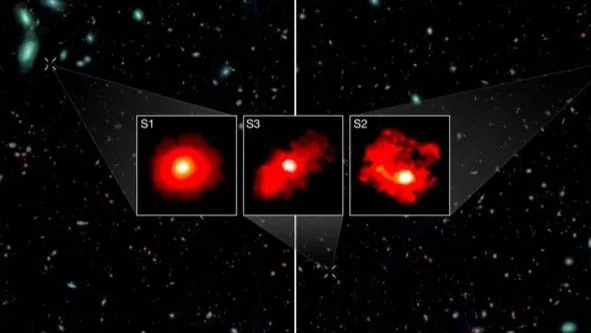
Massive 'Red Monster' Galaxies Discovered by James Webb Challenge Our Understanding of the Cosmos!
2024-11-14
Author: Chun
Introduction
The James Webb Space Telescope (JWST) has made a jaw-dropping discovery in the depths of the early universe: a trio of colossal "red monster" galaxies that defy our current understanding of galaxy formation. These extraordinary galaxies, each boasting a mass equivalent to 100 billion suns, are nearly as massive as our own Milky Way and date back over 12.8 billion years, forming within just a billion years after the Big Bang.
Significance of the Discovery
This revelation poses significant questions about the nature of star formation during the universe's early epochs. According to researchers, the rapid assembly of stars within these galaxies occurred at an astonishing pace, contradicting existing models suggesting that star formation should be a much slower, inefficient process. The findings were published in the prestigious journal Nature on November 13.
Expert Insights
Stijn Wuyts, a co-author of the study and an esteemed professor of astronomy at the University of Bath in the U.K., expressed his astonishment, stating, "Finding three such massive beasts among our sample presents a tantalizing puzzle. Many processes involved in galaxy evolution tend to limit how effectively gas can convert into stars. Yet, somehow, these Red Monsters have surmounted these barriers with remarkable speed."
Traditional Views vs New Findings
Traditionally, astronomers believed that galaxies form within vast halos of dark matter, where gravity pulls in ordinary matter—like gas and dust—before compressing it to give birth to stars. This process is generally inefficient, with only about 20% of the incoming gas transforming into stars. However, the red monsters challenge this perspective, as evidence suggests that up to 80% of their gas has transformed into brilliant, young stars.
Future Research Directions
Lead author Mengyuan Xiao, a researcher from the University of Geneva, highlighted the implications of this discovery: "These results suggest that galaxies in the early universe could have formed stars with an unforeseen efficiency. As we delve deeper into studying these galaxies, they will provide new insights into the conditions that shaped the universe's earliest epochs. The Red Monsters mark the dawn of a new era in our exploration of cosmic beginnings."
Detection Methods
The distinctive red glow of these galaxies earned them their nickname and was detected using JWST's Near Infrared Camera (NIRCam), which analyzes distant light by segregating it into its components. Unlike other telescopes, JWST's advanced infrared capabilities allow it to penetrate deep into the universe, viewing regions obscured by dust.
Continuing the Exploration
The researchers plan to continue their observations of these fascinating red monsters, utilizing both the JWST and Chile's Atacama Large Millimeter Array (ALMA) telescope. The implications of this discovery are profound, prompting astrophysicists to rethink models of early galaxy evolution and consider novel processes responsible for the astonishing rate of star formation in these vast galaxies.
Conclusion
In these early weeks of its operation, the JWST continues to astonish scientists with its revelations, showcasing that some galaxies may reach maturity much quicker than previously thought in the unfolding story of our cosmic history. This groundbreaking discovery promises to reshape our understanding of the universe and what it means to explore the cosmos. Buckle up—ours is a universe full of surprises!



 Brasil (PT)
Brasil (PT)
 Canada (EN)
Canada (EN)
 Chile (ES)
Chile (ES)
 Česko (CS)
Česko (CS)
 대한민국 (KO)
대한민국 (KO)
 España (ES)
España (ES)
 France (FR)
France (FR)
 Hong Kong (EN)
Hong Kong (EN)
 Italia (IT)
Italia (IT)
 日本 (JA)
日本 (JA)
 Magyarország (HU)
Magyarország (HU)
 Norge (NO)
Norge (NO)
 Polska (PL)
Polska (PL)
 Schweiz (DE)
Schweiz (DE)
 Singapore (EN)
Singapore (EN)
 Sverige (SV)
Sverige (SV)
 Suomi (FI)
Suomi (FI)
 Türkiye (TR)
Türkiye (TR)
 الإمارات العربية المتحدة (AR)
الإمارات العربية المتحدة (AR)